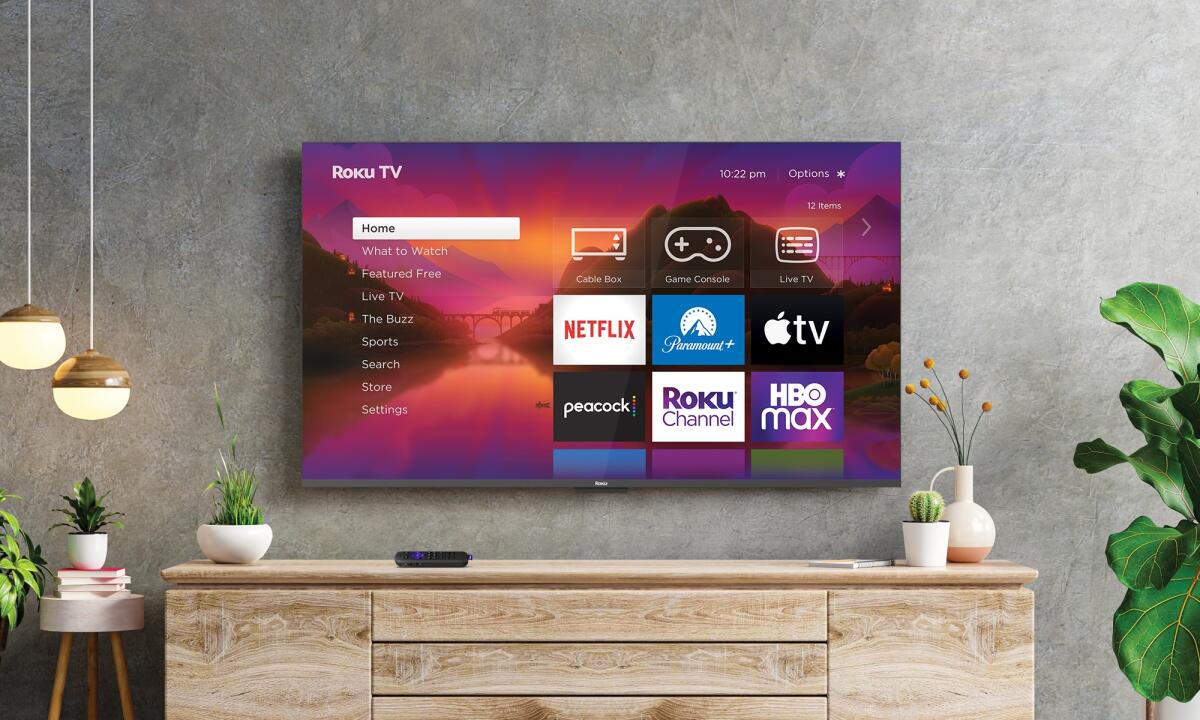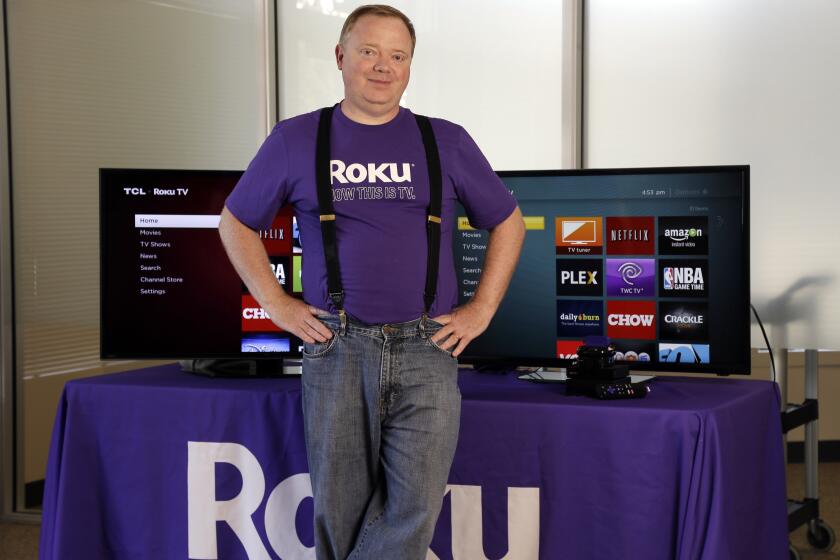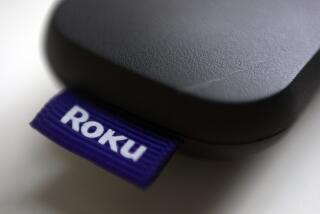Roku TVs are coming to market. Will they help the San Jose streamer rebound?

- Share via
San Jose — During the pandemic, Roku reaped the benefits of the streaming boom, as consumers used its platform to stream movies and TV shows from services like Netflix and Disney+.
The San Jose-based company sold lots of ads on its platform and took in significant revenue from new streaming services seeking to connect with Roku’s more than 65 million users. Roku also began investing in new original programs from its ad-supported streaming service, the Roku Channel, doubling its staff in Santa Monica in 2021.
But over the last year, some investors have grown wary of Roku’s direction, as the company weathers a weaker advertising market and delves into non-TV-related products like video doorbells. Amid a broader rethinking of the streaming business model, Roku’s stock price plunged more than 80% in 2022.
In the face of these headwinds, the company is branching out. On Wednesday, Roku announced it would make and design its own branded TVs. The 11 models, which will sell in the U.S. in the spring, will range from 24 to 75 inches for $119 to $999.
“We believe that a TV made and designed by Roku just makes sense,” said Chris Larson, vice president of retail strategy, in a December press briefing at Roku’s San Jose headquarters.
The move will help Roku build and maintain its presence in smart TVs, as other companies including Google and Samsung are distributing their own rival software, said Paul Gray, research director, consumer electronics for London-based Omdia.
“The TV and video market is turning into a battle of platforms,” Gray said. “As a result, Roku needs to continue to nurture its installed base.”
Whether the TV push will help regain investor confidence in Roku remains to be seen. Roku had projected its fourth-quarter sales would be lower than a year ago in part because of the weaker advertising market. In November, the company announced it would cut 200 U.S. jobs, about 7% of its workforce. Roku makes money through sales of its hardware, licensing of its software, advertising and commissions.
“Our view is that Roku is indeed Broku as a stock (and it remains to be seen if it is Broku as a company amidst all of these hurdles),” wrote Jeffrey Wlodarczak, a principal and analyst at Pivotal Research Group, in a Nov. 3 note. He has a sell rating on the stock.
Roku stock closed at $42.35 on Wednesday, up about 4%.
Tech executive Mark Robins decorates his home in holiday lights synced up to more than two dozen songs. His impressive display caught the attention of Roku’s CEO, which helped Robins eventually land a pivotal role at the streamer.
Roku, founded in 2002, is seen as one of the pioneers of streaming, offering the first connected TV device to stream Netflix, and continues to sell devices that plug into TVs so consumers can access streaming services.
In 2014, Roku expanded its reach by partnering with TV manufacturers to sell Roku’s software already installed on smart TVs and will continue to do so.
Selling its own TVs is a natural progression for the company, executives said.
“This move could fully realize the full potential of our Roku TV program by bringing our content, our award-winning operating system, and hardware all together under one roof, so making our own branded TVs is that natural next step in our company’s evolution,” Larson said.
Roku is the No. 1 streaming operating system in the U.S., with a 33% market share, executives said.
But rivals are not far off, according to data from research firm Omdia. In the third quarter, Roku had a 26.5% share of operating systems in North America, while Samsung’s Tizen had a 27.4% share and Google’s Android had 13.3%, according to Omdia data.
“The competitors are catching up and have a decent enough product,” Wlodarczak said.
Viewers watched an average of nine episodes of former Quibi shows in two weeks on Roku’s free, ad-supported streaming service the Roku Channel, the company said. More people watched than during shows’ entire lives on Quibi.
Roku executives maintain that its software is popular among customers compared with competing platforms because Roku is easy to use and intuitive for them. And selling branded TVs, they say, would further accelerate the growth.
“I think one of the reasons Roku has been successful is that our software or operating system is designed for TV the same way Windows is designed for desktop, the same way Android is designed for phones,” said CEO Anthony Wood in the press briefing.
During the pandemic, the company expanded its presence in Southern California as it grew its catalog of original content.
The new Roku TVs will work with other Roku products, including its internet-connected video doorbells. For example, if a delivery person were to ring the Roku video doorbell at a home, a notification would appear on the user’s Roku TV, telling them that someone was at their door.
Roku is following a path similar to other tech companies such as Google, which had supplied operating software to other manufacturers before making its own branded Google Pixel phones in 2016.
Roku has acknowledged, however, that a looming recession could impact its business.
The company forecast that its fourth-quarter revenue would be $800 million, down from $865.3 million in the fourth quarter of 2021, in part due to weakness in the advertising market. It projected a net loss of $245 million in the quarter, versus a profit of $23.7 million from the same period a year ago. Roku reported a $122-million net loss in the third quarter.
“As we enter the holiday season, we expect the macro environment to further pressure consumer discretionary spending and degrade advertising budgets, especially in the TV scatter market,” Wood and CFO Steve Louden wrote in a shareholder letter in November. “We expect these conditions to be temporary, but it is difficult to predict when they will stabilize or rebound.”
Despite the economic challenges, some analysts are bullish on the company’s future.
“I really think you’re going to see an ad shift from commercial broadcast to what we call advertising (supported video) on demand,” said Michael Pachter, managing director, equity research for Wedbush Securities, who has an outperform rating on the stock. “Then that means that somebody’s gonna have to deliver those ads and be in the middle of it, and Roku is well-positioned to thrive when that happens.”
As popularity for the ad-supported Roku Channel has grown, San Jose-based Roku more than doubled its staff in Santa Monica last year.
More to Read
Inside the business of entertainment
The Wide Shot brings you news, analysis and insights on everything from streaming wars to production — and what it all means for the future.
You may occasionally receive promotional content from the Los Angeles Times.













